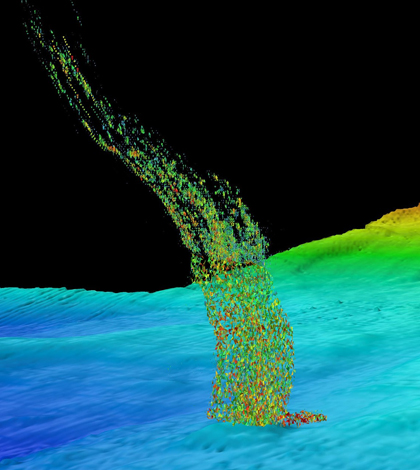Warming Pacific releases methane equivalent to Deepwater Horizon spill each year

The ocean keeps secrets from surface to seafloor, and some even deeper still. A group of researchers from University of Washington discovered one such secret by accident — and their findings could change the scientific world’s understanding of climate change and its relation to the Pacific.
“In 2013, we were preparing for a research expedition that had nothing to do with this,” said Evan Solomon, assistant professor of oceanography at UW. “We wanted to get a long-term record of bottom water temperature variability.”
The team gathered conductivity, temperature and depth profiles off the Washington coast. A comparison with other research quickly revealed a long-term trend of warming in the area. Further statistical analysis and data reduction made it clear that the warming was concentrated around 500 meters below the surface — the same region, Solomon said, where natural gas is emitted as bubble plumes from seafloor seeps.
Around the same time of the discovery, local fishermen were sending the researchers images from their fishfinders: massive plumes at the depth where the warming was greatest. This, Soloman said, caught the researchers’ attention.
“I was skeptical at first,” he said. “I was like, ‘Okay, maybe I don’t know, but all these things are linking up, so maybe we should do this.’”
Drawing from over four decades of data, Soloman and other researchers conducted a study looking at the release of methane at the bottom of the Pacific. The paper containing their findings appeared in the scientific journal Geophysical Research Letters.
The 500-meter mark is a crucial one for certain oceanic processes. It’s here that methane leaves its solidified form as a hydrate to become methane gas, a transformation that can be expedited by rising temperatures. Since 1970, methane hydrates have retreated from shore by a kilometer or so. But it’s not really going away, just changing form by dissipating into the water — and possibly the atmosphere.
So just how much methane is being released? Solomon says he likes to drive the point home with an image that most people can easily conjure: “About the same amount of methane that released during the Deepwater Horizon event” seeps from Washington’s coast each year, he said.
That estimate, of course, is derived from a model built off thousands of historical temperature measurements. Last October, Soloman and fellow UW professor Paul Johnson embarked on another voyage to verify their model with updated data. They focused on the locations provided by fishermen, not knowing if they would find the seeps at all.

Researchers gather sediment samples off Washington’s coast. (Credit: Robert Cannata / UW)
Though the weather was awful, churning up waves that induced seasickness even in the hardiest of the researchers, their faith in the anglers was rewarded.
“We went to the first fisherman location and fine-tuned the location of the seep site based on our sonar,” Soloman said. Sure enough, there it was. But they didn’t find just one: “Every single one of those seeps were active when we went out there,” he said. “If it wasn’t for the fishermen, it would have been a much more difficult task.”
The researchers took water and core samples near the seeps. “That provides two things,” Soloman explained. “The core sampling will allow us to understand if the hydrates are indeed dissociating like our models predict, and the water samples provide information on the fate of that methane in the water column.”
Soloman said it will be a couple of months before the researchers finish analyzing their samples. But if the samples confirm what the model suggest, that’s a “big deal.” As they continue their work, the researchers may look at how the dissociation process is changing over time. A long-term monitoring study could incorporate additional sites to examine the broader picture of seafloor methane release. But the bigger issue is determining where that methane goes, whether it’s consumed by microbes, absorbed into the water column or escapes into the atmosphere.
“All we can say from our models right now is intermediate water warming may be causing that portion of the hydrate deposit to dissociate and release methane,” he said. “The important question is what happens to it.”
Top image: Sonar image of bubbles rising from the seafloor. (Credit: Brendan Philip / UW)





0 comments